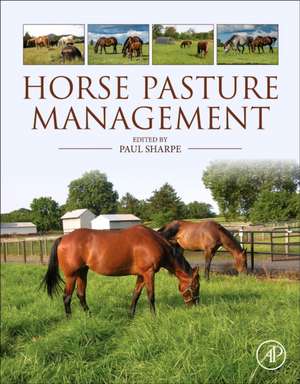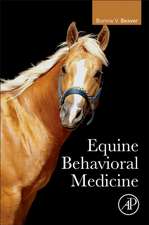Horse Pasture Management
Editat de Paul H. Sharpeen Limba Engleză Paperback – 12 noi 2018
Contributions are rounded out with a chapter explaining the economic benefits of improvements in pasture management.
- Provides the basic principles of pasture management for those involved in equine-related fields and study
- Covers a variety of strategies for managing the behavior, grouping, environment, and feeding needs of animals to ensure horse welfare and health
- Includes information on environmental best practices, plant and soil assessment, and wildlife concerns
- Highlights case studies of successful, existing extension programs
| Toate formatele și edițiile | Preț | Express |
|---|---|---|
| Paperback (2) | 499.23 lei 5-7 săpt. | |
| ELSEVIER SCIENCE – 12 noi 2018 | 499.23 lei 5-7 săpt. | |
| ELSEVIER SCIENCE – 26 noi 2024 | 580.04 lei 5-7 săpt. | +87.73 lei 6-10 zile |
Preț: 499.23 lei
Preț vechi: 657.29 lei
-24% Nou
95.54€ • 103.74$ • 80.25£
Carte tipărită la comandă
Livrare economică 16-30 aprilie
Specificații
ISBN-10: 0128129190
Pagini: 442
Dimensiuni: 216 x 276 x 26 mm
Greutate: 1.18 kg
Editura: ELSEVIER SCIENCE
Public țintă
Advanced students, professors, and academics involved in certificate, diploma or degree programs in equine studies and horse management, agricultural and equine extension specialists and consultants; researchers in these areas and horse behavior, physiology, and nutrition; veterinarians; feed industry staff; 4-H and Pony Club leaders.Cuprins
1. Forage plant structure, function, nutrition and growth 2. Nutritional value of pasture plants for horses 3. Identification of forage plant species 4. Soil types, structure, properties that affect pastures, nutrients, acidity, fertility and management and potential for forage growth 5. Pasture establishment methods 6. Pasture plant management and renovation 7. Forage yield and its determination 8. Weed identification 9. Managing Weeds 10. Toxic Plants and other hazards 11. Grazing behavior, feed intake and feed choices 12. Grazing Management and Stocking Rates 13. Calculating stocking rates, stocking intensities and numbers of rotational grazing paddocks 14. Multi-species grazing (cattle, goats, sheep) 15. Turf management for equestrian sports 16. Hay and silage production and management 17. Climate, Weather and Plant Hardiness 18. Matching plant species to your environment, weather and climate 19. Manure Management 20. Environmental Protection with Streamside Grazing Method 21. Renovating Wet Areas in Pastures and Yards 22. Fencing and watering systems 23. Avoiding Metabolic Problems 24. Managing Drought and Flood Conditions 25. Co-existing With Wildlife 26. The University of Kentucky Extension Pasture Evaluation Program 27. The University of Maryland Equine Rotational Grazing Site 28. Economic benefits of improvements in pasture management
Descriere
Horse Pasture Management begins with coverage of the structure, function and nutritional value of plants, thus instructing those working and studying equine management on how to identify pasture grasses, legumes, weeds and toxic plants. Management of soil and plants in a pasture is covered next, followed by horse grazing behavior, feed choices of horses, management of grazing horses, and how to calculate how many horses should be grazing relative to land size. In addition, sections on turf management for equestrian sports and making and preserving hay and silage are included, amongst many other topics.
Contributions are rounded out with a chapter explaining the economic benefits of improvements in pasture management.
- Provides the basic principles of pasture management for those involved in equine-related fields and study
- Covers a variety of strategies for managing the behavior, grouping, environment, and feeding needs of animals to ensure horse welfare and health
- Includes information on environmental best practices, plant and soil assessment, and wildlife concerns
- Highlights case studies of successful, existing extension programs


